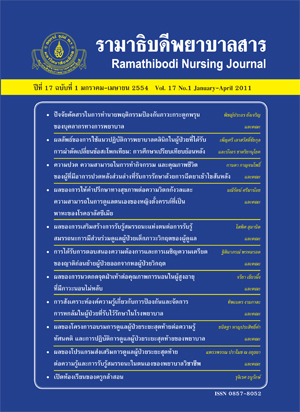ผลของการนวดกดจุดฝ่าเท้าต่อคุณภาพการนอนในผู้สูงอายุที่มีภาวะนอนไม่หลับ
Main Article Content
Abstract
บทคัดย่อ
การวิจัยครั้งนี้เป็นการวิจัยเชิงทดลองโดยการสุ่มเข้ากลุ่มวัดผลก่อนและหลังการทดลอง เพื่อศึกษาผลของการนวดกดจุดฝ่าเท้าต่อคุณภาพการนอนในผู้สูงอายุที่มีภาวะนอนไม่หลับ ทำการศึกษา ณ ห้องตรวจการนอนหลับ ภาควิชาอายุรศาสตร์ คณะแพทยศาสตร์โรงพยาบาล รามาธิบดี จำนวน 40 ราย ตั้งแต่เดือนกรกฏาคม พ.ศ. 2552 ถึงเดือนตุลาคม พ.ศ. 2552 คัดเลือก กลุ่มตัวอย่างตามเกณฑ์ที่กำหนดแบ่งเป็นกลุ่มควบคุมที่ได้รับการพยาบาลตามปกติและกลุ่ม ทดลองที่ได้รับการนวดกดจุดฝ่าเท้าตามคู่มือนวดกดจุดฝ่าเท้า กลุ่มละ 20 ราย ทั้งสองกลุ่มได้ รับการตรวจการนอนหลับด้วยเครื่องตรวจการนอนหลับโพลีซอมโนกราฟฟีในหนึ่งคืนของการ ทดลอง โดยแบ่งการวัดการตรวจเป็น 2 ระยะ ได้แก่ ระยะ 3 ชั่วโมงแรกและในระยะ 6 ชั่วโมง (หนึ่งคืนของการทดลอง) เครื่องมือที่ใช้ในการศึกษา ได้แก่ แบบประเมินคุณภาพการนอน หลับ เครื่องตรวจโพลีซอมโนกราฟฟี ผลการศึกษา พบว่า การนวดกดจุดฝ่าเท้าในกลุ่มทดลอง ช่วง 3 ชั่วโมงแรกของการนอนหลับมีค่าเฉลี่ยของระยะเวลาของการนอนหลับในระยะที่ 2 น้อย กว่ากลุ่มควบคุม (ในการเข้าสู่ระยะการนอนหลับลึก) ระยะการนอนหลับแบบ NREM คิดเป็น นาทีใช้เวลาน้อยกว่าและมีค่าใกล้เคียงกับค่าปกติดีกว่ากลุ่มควบคุม (ในการเข้าสู่การนอนหลับ แบบ REM) และระยะเวลาการนอนหลับ REM คิดเป็นเปอร์เซ็นต์จะมีค่าใกล้เคียงกับค่าปกติ ดีกว่ากลุ่มควบคุมอย่างมีนัยสำคัญทางสถิติ เมื่อเปรียบเทียบค่าเฉลี่ยคุณภาพการนอนหลับมิติ ความแปรปรวนการนอนหลับ ประสิทธิภาพการนอนหลับ ระยะเวลาการนอนหลับ ไม่พบความ แตกต่างระหว่างสองกลุ่มอย่างมีนัยสำคัญทางสถิติ การนวดกดจุดฝ่าเท้าเป็นกิจกรรมทางเลือก หนึ่งของการดูแลแบบผสมผสานแบบองค์รวม ช่วยส่งเสริมการนอนหลับซึ่งส่งผลให้ผู้สูงอายุมี คุณภาพชีวิตที่ดีขึ้น
คำสำคัญ : การนวดกดจุดฝ่าเท้า, คุณภาพการนอน, นอนไม่หลับ, ผู้สูงอายุ, การแพย์ทางเลือก
Abstract
This study was an experimental study with a randomized control group pretest-posttest design, aiming to study the effect of foot reflexology on the quality of sleep in older persons with insomnia. The study was conducted with 40 older patients who were referred to have polysomnography at the sleep laboratory, Department of Medicine, Ramathibodi Hospital from July 2009 to October 2009. The sample was chosen based on the purposive criteria and randomly assigned into a control group receiving usual nursing care or an intervention group receiving foot reflexology, with 20 patients in each group. Both groups underwent a sleep test by polysomnography for one experimental night. The measurement was divided into 2 phases: the first 3 hours and the next 6 hours. The research instruments included the Quality of Sleep Assessment Form, the Demographic Data Form and Polysomnography. The data were analyzed using descriptive statistics, Chi-square, Mann-Whitney, independent t-test, and ANCOVA before and after the intervention for both groups. Findings of the study revealed that there was a shorter length of stage 2 sleep time in the intervention group during the first 3 hours of sleep. The NREM sleep time (min.) was lower and closer to the standard value in the intervention group. The percentage of REM sleep time in the intervention group was closer to the standard value than that in the control group with statistical significance. When comparing the mean of quality of sleep regarding variance of sleep, sleep efficiency, and sleep time before and after the experiment between two groups, no significant difference was found. According to this study, foot reflexology was an alternative activity of holistic nursing care that could contribute to better quality sleep in older persons. As a result, nurses should acquire supporting data for applying reflexology to promote sleep in a holistic way for better quality of life of the older persons.
Keywords : Foot reflexology, Quality of sleep, Insomnia, Older persons, Alternative medicine
Article Details
บทความ ข้อมูล เนื้อหา รูปภาพ ฯลฯ ที่ได้รับการตีพิมพ์ในรามาธิบดีพยาบาลสาร ถือเป็นลิขสิทธิ์ของวารสาร หากบุคคลหรือหน่วยงานใดต้องการนำทั้งหมดหรือส่วนหนึ่งส่วนใดไปเผยแพร่หรือเพื่อกระทำการใด ใด จะต้องได้รับอนุญาตเป็นลายลักษณ์อักษรจากรามาธิบดีพยาบาลสารก่อนเท่านั้น


